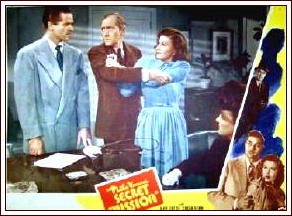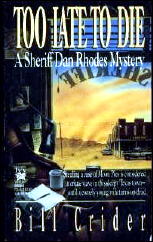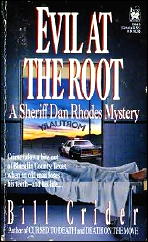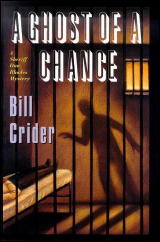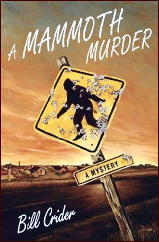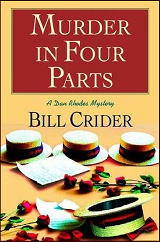April 2010
Monthly Archive
Sun 18 Apr 2010
Posted by Steve under
Reviews[2] Comments
A REVIEW BY MARYELL CLEARY:
REGINALD HILL – Deadheads. Macmillan, US, hardcover, 1984. Collins Crime Club, UK, hc, 1983. Paperback reprint: Signet, US, 1985.
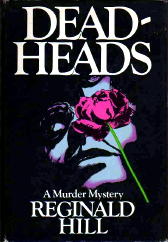
Deadheads is a tour de force in more ways than one. Each chapter is named for a rose, whose characteristics make up the chapter heading; each is appropriate to the content, from “Mischief” for Chapter 1 to “F�licit� et Perpetu�” at the end.
The title is a double entendre. Is it just coincidence that people die so conveniently for Patrick Aldermann, owner of the Rosemont estate and proud grower of roses? His employee, “Dandy Dick” Elgood, is suspicious and tells the police so, but then withdraws the complaint.
But policemen are not so easily called off. Sergeant Pascoe is intrigued by another coincidence, his wife Elly and Aldermann’s wife Daphne meeting and becoming friends just as the investigation starts. Superintendent Dalziel, now being likened by his subordinates to a dinosaur, takes the opportunity of a conference in London to renew an old acquaintanceship with Aldermann’s mother, and thereby furthers the investigation.
In collateral roles ugly Sergeant Wield, a secret but unrepentant homosexual, and police cadet Shaheen Singh, Yorkshire born and bred, are interesting additions to the police cast. Suspense is maintained right up to a smashing ending. A gripping story with well-realized characters — Hill gets better and better.
� Reprinted from The Poisoned Pen, Vol. 6, No. 4, Fall 1986.
Previously reviewed on this blog:
Midnight Fugue (by Ray O’Leary)
Ruling Passion (by Steve Lewis)
Sat 17 Apr 2010
Posted by Steve under
Covers ,
Reviews[7] Comments
Reviewed by DAVID L. VINEYARD:
WILLIAM SLOANE – To Walk The Night. Farrar & Rinehart, hardcover, 1937. World/Tower, hc reprint, 1946. Paperback reprints include: Penguin-US #550, 1944; Dell #856, 1957; Bantam H3426, 1967; Del Rey, 1980.
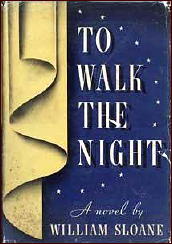
There are books that are not only genuinely scary, but more importantly genuinely disturbing. The scream or the sudden start is less part of their impact, than the frisson, that deep chill that rises from the soul and is often described as feeling as if someone has walked over your grave.
Most writers only manage one of these, however masterful their output: Cornell Woolrich’s Night Has 1000 Eyes (written as George Hopley), Shirley Jackson’s The Haunting of Hill House, Thomas Tryon’s The Other, Gordon Williams’ Neither the Sand Nor the Sea, Fritz Leiber’s Conjure Wife, Jack Williamson’s Darker Than You Think, and William Lindsey Gresham’s Nightmare Alley are a few examples of the form.
William Sloane was unique in that he wrote two books that fit this category. They were the only two books he wrote in a long and distinguished literary career which included being a vice president at Holt, editorial director at Funk and Wagnalls, director of Rutgers University Press, and founder of William Sloane Associates. Indeed, writing two classics on top of all that seems like overkill.
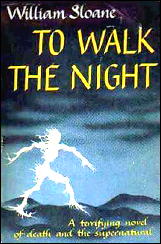
But classics they are. By far the best known of the pair was The Edge of Running Water (aka The Unquiet Corpse and filmed as The Devil Commands (reviewed here )), an acknowledged classic of the Campbellian school of fiction represented by the pulp magazine Unknown (despite the fact Sloane’s novels predate the Unknown school) where science fiction, fantasy, horror, the thriller, and the genuine gothic all cross.
But while Edge of Running Water is a genuine classic and a great work, by far the novel that held my imagination longest and still does was Sloane’s first novel, 1937’s To Walk the Night. It’s frights are more subtle than The Edge of Running Water, but no less disturbing.
To Walk the Night unfolds like a mystery novel. Bark Jones has gone home to visit Dr. Lister, the father of his friend Jerry, and together they hope to lay the mystery that revolves around the deaths of Jerry, and before him Jerry’s mentor astronomer Professor LeNormand. The one key to both men’s deaths is LeNormand’s, and now Jerry’s widow, Selena.
Selena.
There aren’t many women in fiction like Selena. She could stand beside Rider Haggard’s Ayesha without so much as a blush. She makes her entrance after her husband’s death — seemingly by spontaneous combustion — and for Jerry it is love at first sight. For Bark it is something else. A mystery that is both fascinating and horrible in its implications.
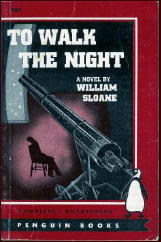
The nearest I can come to a description of her is to say she was like one of the beggars on a city street whose faces are indifferent to life because they no longer have anything to hope from it. She was not tragic, or sorrowful, or frightened. She was simply indifferent.
She is also stunningly beautiful though she dresses badly and seems equally indifferent to her beauty. Jerry woos her, and not two months after LeNormand’s death they marry and move to their new home in the American Southwest where Jerry plans to continue his mentors studies.
Meanwhile Bark continues to probe and try to put together some sense from Selena’s manner. Who is she? She doesn’t seem to have existed before two years earlier, and yet she closely resembles a severely brain damaged girl who disappeared at the same time Selena showed up.
At times she seems to actually have loved LeNormand and to love Jerry, and yet there is no passion in her, no humanity, and she is oddly and inexplicably ‘other.’ At one point she brakes a car before anyone could have known of the obstacle that appears before her.
She is simply not quite human, based on the smallest of evidence — the way she out shines a nightclub magician, or her strange ignorance of the most common of things. And yet she is a superb dancer, a normal housewife, and in her own way seems to genuinely love her husband.
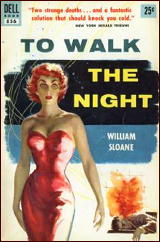
But Jerry will not abandon his research, and as he comes closer to the same revelations that drove his mentor, a crisis is approaching.
The detail of incident is built slowly and Bark frequently apologizes to the reader for dwelling on the tiny incidents that comprise his story. But subtly and with increasing tension the reader begins to feel the very real dread that is building — much like a nightmare that one can’t be awakened from. Even Jerry feels it, something is not quite right:
“I feel all the time as if she was holding something back. Sometimes it’s almost as if she felt I wasn’t old enough to know something. And I can’t find out what it is. What it is she knows that I don’t. There’s something in between us, that’s all.”
Probably every married man has experienced that feeling at some point in his marriage, no matter how happy his marriage is overall, but with Selena the worry is real. It’s a mark of Sloane’s skill as a writer that he manages a moment of genuine frisson from a fairly normal moment between a man and a woman that in other hands might spark an episode of a sitcom.
What that something is worries at Jerry’s mind. He knows if he can identify it he can lay not only the mystery of what or who killed LeNormand, but also put an end to that distance between he and Selena.
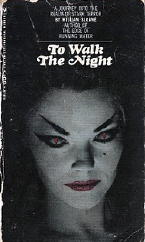
And in a way he is right, because LeNormand’s calculations are the key to everything; his death, Selena’s peculiar nature, and Jerry’s fate, and unraveling that final mystery will be a fatal mistake. Some things we aren’t meant to know …
To Walk the Night (the title comes from Selena’s nocturnal walks in the high desert) does not disappoint. The solution veers into true science fiction, and yet I can’t honestly call this a science fiction novel. It reads much more like a suspense novel or a true gothic. In fact what genre, if any, it belongs to is a minor consideration. It transcends genre, and stands on its own as simply a stunningly good read.
Sloane is a first rate writer and the novel is beautifully written. The ending is haunting, and yet understated with genuine power.
Don’t finish this one right before bed. You are apt to have a restless night, not so much from fear exactly, but because you can’t quite let go of this, even when you want to.
I’ll let Selena speak for herself. This speech is from Selena to Jerry’s father, Dr. Lister, near the very end of the novel:
“Do you imagine that you are the ultimate product of creation? There is nothing unique about you.” Her tone was so level, so coldly insistent that even Dr. Lister seemed to shrink in upon himself. “Is there any reason why I must leave you alone? You do not own me and you have no power over me. Why,” she said, and there was an edge of blanket amusement in her tone, “when the earth has traveled around the sun a few more times, you will be dead.”
Though she addresses herself to Jerry’s father, it is mankind she is speaking to, and mankind itself that will no longer exist when the world has ‘traveled around the sun a few more times.’
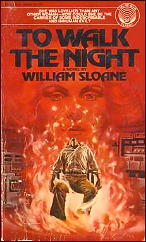
This would have been a remarkable novel to be written after the birth of the nuclear age and after the devastation of the Second World War. To be written before it is all the more remarkable.
By all means read this one. But keep the light on. And for those of you married men, if you find yourself wondering about the ‘other’ in your life, blame Sloane, not me. To Walk the Night is a murder mystery, and it does have real clues, and an actual solution, but like Robert Louis Stevenson’s The Strange Case of Dr. Jekyll and Mr. Hyde, the solution may well be more horrible than the crime.
Note: There seems to be some confusion as to whether the 1963 British film Unearthly Stranger with John Neville is based on Sloane’s novel or not. The stories are similar, but not having seen the film I don’t know if Sloane is credited in the screen credits or not.
IMDb does not mention Sloane as the source for the film, but I have seen it described elsewhere as being based on Sloane’s novel. Maybe someone out there can solve the mystery. No doubt it will be a less disturbing solution than the one to Sloane’s novel.
Sat 17 Apr 2010
A TV Review by MIKE TOONEY:
“The Thirty-First of February.” An episode of The Alfred Hitchcock Hour (Season 1, Episode 15). First air date: 4 January 1963. David Wayne, William Conrad, Elizabeth Allen, Staats Cotsworth, William Sargent, Bob Crane, King Calder, Bernadette Hale, Kathleen O’Malley, Robert Carson. Teleplay: Richard Matheson, based on the novel The Thirty-First of February (1950) by Julian Symons. Director: Alf Kjellin.
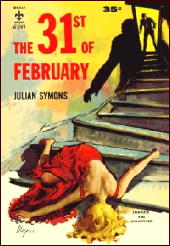
As the play opens, an inquest is being held into the death of Valerie Anderson (Kathleen O’Malley), who evidently tried to walk down a flight of steps to her cellar, despite a burned-out light bulb, stumbled, and broke her neck in the fall. Everything seems to point to accidental death, and the coroner rules it that way.
Val’s husband Andrew (David Wayne) decides the best thing to do would be to go immediately back to work. But it’s there among his colleagues that things begin to deteriorate.
Little items which would ordinarily be minor annoyances begin to crop up and incrementally erode Andrew’s sangfroid: a desk calendar marking the date of Val’s death, an unsigned poisoned pen letter implying Val was having an affair with someone at the firm, two interoffice memos that get mixed up and sent to the wrong people, a new employee who seems to be following Andrew around, another desk calendar with the nonsensical date of “February 31st” inscribed on it, and even having his house ransacked.
And then there’s that police sergeant (William Conrad), who on every occasion they meet keeps insinuating that Andrew murdered Valerie but insists he isn’t implying any such thing.
Not only is Andrew’s emotional composure slowly cracking, but his vulnerabilities are also becoming more obvious. You see, Andrew never loved Val; he admits as much to the woman he really loves, Molly O’Rourke (Elizabeth Allen) — but he does so just before he tries to choke her. He also comes to believe that several of his colleagues, as per the letter, were having an affair with Valerie and irrationally accuses them to their faces, making him look even more paranoid.
One thing’s for sure: If Andrew did kill Val, then his guilty conscience is tearing him apart — but, if he didn’t kill her, then he’s in the crosshairs of a plot not just to put him in prison but also to drive him insane ….
David Wayne’s criminous credits include Hell and High Water (1954), as The Mad Hatter on four episodes of TV’s Batman (1966-67), Arsenic and Old Lace (TVM, 1969), one Banacek (1973), as Inspector Richard Queen (sans moustache) in 23 episodes of Ellery Queen on TV (1975-76), and an appearance on Murder, She Wrote in a clever locked-room mystery, “Murder Takes the Bus” (1985).
William Conrad was always playing heavies, both figuratively and literally. Credits include The Killers (1946), Body and Soul (1947), Sorry, Wrong Number (1948), Tension (1949), East Side, West Side (1949), One Way Street (1950), Dial 1119 (1950), Cry Danger (1951), The Racket (1951), Cry of the Hunted (1953), The Brotherhood of the Bell (TVM, 1970), as Nero Wolfe on TV (14 episodes, 1981), and in the series Jake and the Fatman (104 episodes, 1987-92).
Hulu: http://www.imdb.com/video/hulu/vi853016601/
Fri 16 Apr 2010
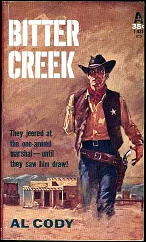
AL CODY – Bitter Creek. Avon T-431, paperback, no date [1960]. Hardcover edition: Dodd Mead, 1947. Earlier pb reprint: Pocket #769, December 1950.
When a one-armed Civil War veteran comes home to his ranch and fiancee, he discovers that both his ranch and fiancee have been stolen from him by a long-time rival. This is my favorite type of western story, I think, and this one has some sharply pleasing twists of coincidence to go with it. Tightly plotted, with many of the characters a solid notch beyond cardboard.
BRIAN WYNNE GARFIELD – Vultures in the Sun. Ace F-300, paperback reprint, no date [1964?]. Hardcover edition: Macmillan, 1963. Later paperback reprint: Bantam, 1987.
Another common theme in western novels is that of the gunfighter who would like to quit and settle down, but can’t. In this one, when Ethan Scott agrees to rid a town of outlaws, he knows full well that when the job is done, he won’t be wanted around much longer. The story is moody and introspective, and it often seems static and unmoving, but the characters are strong and memorable. Good stuff.
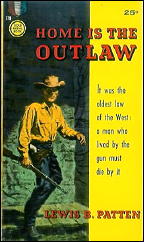
LEWIS B. PATTEN – Home Is the Outlaw. Gold Medal #778, paperback original, June 1958.
An echo of the preceding book, developed in a much more obvious fashion, and punctuated instead by almost constant action. Gunfighter Morgan Orr returns to his home town to try to make a new life for himself, only to find the woman he remembers no longer available, and a guilty secret ready to burst the town wide open. This is a violent book, but one that’s tough to put down.
— Reprinted from Mystery*File #35,
November 1993.
[UPDATE] 04-16-10. A footnote to these three reviews at the time says that I’d just purchased a lot of 600 western paperbacks, of which I’d kept 450 for myself. As I recall, until I obtained this lot, I hadn’t been reading westerns as part of my regular diet for quite a while — ever since the mid-1960s — so I was devouring them quickly.
Also note how short these reviews were. I was going through a kind of writer’s block at the time, and I was forcing myself out of it by making my reviews as brief and concise as I could.
Fri 16 Apr 2010
REVIEWED BY DAN STUMPF:
P. J. Universal, 1968. George Peppard, Raymond Burr, Gayle Hunnicutt, Brock Peters, Wilfrid Hyde-White, Jason Evers, Coleen Gray, Susan Saint James, Severn Darden. Director: John Guillermin.
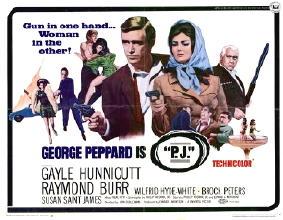
A year after Gunn (1967, and reviewed here ) at Universal they took tastelessness and raised it to a high art in a B-movie I dearly love called P. J., with George Peppard surprisingly believable as a not-too-bright PI up against Raymond Burr as a nasty gazillionaire who hires him to protect his mistress (Gayle Hunnicutt) who’s been getting anonymous threats — or has she?
The threats are understandable since Burr’s family (including Colleen Gray, Susan St James and some guy doing a bad Paul Lynde impression. Remember Paul Lynde?) don’t like the way Burr flaunts his girlfriend around. In fact, there isn’t much to like about him in this film; it’s one of his nastiest parts in a film career full of brutes, wife-killers and at least one gorilla suit, leading Peppard to quip, “That’s what I like about you; you’re all arm-pit,” which is about the level of wit here.
In fact, tackiness is the major charm of a film that loves to wallow in its own disrepute. P. J. starts off in a seedy motel room and moves on to a run-down gym where worn-out pugs fight for a job. When it moves to the haunts of the very rich, we get garishly decorated apartments, sterile offices, and a nightclub where bikini-clad dancers swish their butts around in a giant martini. Real class.
Later on, a studio jungle in a back-lot Caribbean island elevates the cheapness to something like epic scale, followed by a return to New York for some more engagingly crude violence, including a guy getting dragged to his death in a subway tunnel and a fight in a gay bar where our hero gets mauled.
But like I say, these things are the backbone of a movie that returns the Private Eye to Chandler’s Mean Streets, updated to the 1960s and slashed with Technicolor, but meaner than ever, with an added layer of corporate greed that seems relevant today but may be merely timeless.
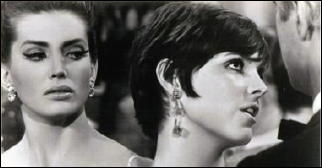
Peppard stalks through it all like a once-promising leading man resigned to doing B-pictures, with added zing provided by John Guillermin’s punchy direction (he did Tarzan’s Greatest Adventure) and a script that tries for wit but settles for sarcasm.
A few other points before I leave this charmer: I reviewed this movie once before about thirty years ago, and at that time I reviewed it in the past tense because it didn’t exist anymore; when P. J. was released to television (which was mainly where you saw old movies back then) they cut out all the sex and violence, toned down the unsavory elements and turned a crude movie into an insipid one.
For decades, this was the only print available, but thanks to the internet and cheap DVD technology, the film has risen again, with all the ugly charm of a monster in an old movie.
Secondly, I should caution prospective viewers that this film takes a very retro view of gays. The movies openly recognized homosexuals in the late 1960s, but they were almost invariably portrayed unsympathetically and even demeaningly.
Like everything else in the movie, P. J. turns this up a notch, with Severn Darden in a performance he should be heartily ashamed of as a lisping, mincing, quivering sissy. Add to this an extended fight in a gay bar that looks like one of the lesser circles of Hell, and you can see how gays — or those who believe they should be treated like human beings — could get quite offended here.
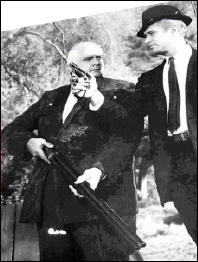
Finally, a word about Raymond Burr’s performance. In my youth I watched films like this in search of a role model. Well, Raymond Burr in this movie looks so eerily like one of our recent vice-presidents that I wonder if someone else saw the film back in ’68 and fixated on him.
The character enjoys nastiness for its own sake, relishing the humiliation and even torture he can inflict on others.
He even goes to one of those clubs where birds with clipped wings are released on cue for “hunters” to blast away at. The similarities are positively unsettling, and I begin to wonder if the film was simply unavailable for so many years, or actually repressed by the previous administration.
Editorial Comment: I’ve scouted around some, and what I’ve discovered is that P. J. has apparently never been officially released on DVD, but it does exist in its original “unexpurgated” form and can be easily found on the collector-to-collector market.
Thu 15 Apr 2010
PHILO VANCE’S SECRET MISSION. PRC, 1947. Alan Curtis (Philo Vance), Sheila Ryan, Tala Birell, Frank Jenks, James Bell, Frank Fenton, Paul Maxey. Screenplay: Lawrence Edmund Taylor. Director: Reginald Le Borg.
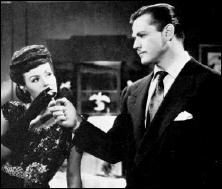
I have three major complaints about the title of the film. First of all, handsome and dashing Alan Curtis does not fit the picture I have in my head of Philo Vance at all. Secondly, he’s not on a mission in this movie, and even if he was, it’s hardly a secret.
So, scratch the title. What do you have left? Plenty, if you think murder mysteries ought to be filled with witty banter between the detective and the pretty girl (Sheila Ryan) who tags along with him as he questions suspects and investigates shots in a house in the middle of the night.
Or not so witty banter between the detective and his not so witty sidekick (Frank Jenks), who only purpose in the movie is to — scratch that. I don’t think he had one, except to ogle good-looking women and pretend to one of them that he’s the real “detectative” of the pair.
Dead is the head of a pulp magazine publisher — this was interesting — who wants to branch out and publish mystery fiction in hardcover as well as magazines with lurid covers. (Sheila Ryan is posing for one of them as the movie begins.)
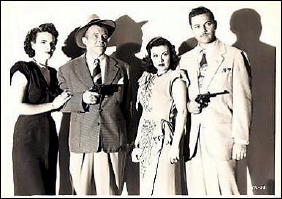
But to get back to the pulp magazine publisher, what he wants Vance to do is to write a story about a case he (the publisher) has solved — that of the disappearance and probable murder of a third partner of the firm seven years earlier.
And of course he, the publisher, gets bumped off before he can tell Vance his theory of the case. There is a lot of foolishness that ensues, but there is at least one truly surprising turn of events that occurs before it all ends, in less than an hour’s total time, and an ending that’s at least decent from a perspective of a detective story fan, which I am assuming you are as well as I.
I’m told by IMDB, that of the three Philo Vance movies PRC made in 1946 and 1947 (with Alan Curtis in two of them) that this was the first to be filmed and the last to be released. I don’t know how that squares with Vance and his lady sidekick apparently heading to a wedding chapel at the very end of the film, but they do, and for some reason that tickled me as much as anything else in this movie.
Thu 15 Apr 2010
Posted by Steve under
Reviews[15] Comments
LEE CHILD – One Shot. Delacorte, hardcover, June 2005. Reprint paperback: Dell, March 2006. Deluxe paperback: Dell, October 2009.
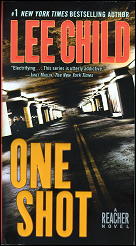
I’m not sure what the correct terminology is to describe the new size that publishers have dreamed up to sell their wares in paperback over the past couple of years or so.
Taller and usually thicker than the standard mass market size, but not wider, the primary purpose is to be able to charge two or three dollars more. Some books come out in softcover only in this size, others like One Shot, are repackaging jobs.
They fooled me, just like I’m sure they hoped they would. I thought this was a new book, and here it is, almost five years old. No matter, I suppose, as I don’t seem to have obtained it when it first came out in hardcover or regular-sized paperback, and at 466 pages of relatively small print, I think at $9.99, I got my money’s worth.
This is a Jack Reacher novel, the ninth out of fourteen, and the first I’ve read. Reacher, from all accounts, is very popular, and I can see why. A drifter and a loner and a fighter for justice (as he sees it) at 6 foot 5 and around 250 pounds, he’s quite a force to be reckoned with, if he’s not on your side.
He’s a former military policeman (13 years), but he’s been out of the service and on the road for some time already by the time One Shot starts. A crazed gunman has killed five people in a small Indiana city, and when captured, he asks for Reacher from his hospital bed. Only thing is, Reacher is already on his way there, so if of the other side needs any help.
Seems like the guy has done this sort of thing before, only it was hushed up, and Reacher wants to make sure he’s wrapped up as tight as he can be, so it won’t happen again.
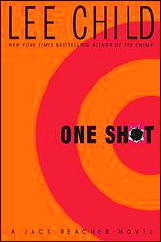
Only thing is, the details are wrong. Tiny ones at first, then small ones, and as time goes on, the wronger they get. Lee Child knows how to structure a story, there is no doubt it. I dare you to read this and take your time about it.
The other only thing is, if you forgive me for this, the longer the story goes on, the less and less likely it gets. You may have guessed that someone and/or something else is behind the killings, and your guess would be correct.
That such a complicated scheme — and yes indeed, it is complicated — why else would 466 pages of relatively small print be needed? — would be put together for such a relatively matter (although I am not a crazed gunman, or anything close to one — I hope) is beyond anything resembling a normal state of affairs, or very nearly so.
Reacher is awfully likable as a hero, though — larger than life, you might say — even though the ending is (in comparison to the rest of the book) fairly perfunctory, falling back on (foolish) bravado and extended gunplay as it does, and Reacher himself rides off into the sunset far too quickly for my own satisfaction.
Will I read another? I’m sure I will.
Thu 15 Apr 2010
Posted by Steve under
Reviews[3] Comments
Reviewed by DAVID L. VINEYARD:
PAUL SAVOY – Black Moon of the Mummy. A Kiwi Crime Classic: Kiwi Press, hardcover, 1959. Also published as Moon of the Mummy and Shadow of the Mummy. Serialized in Man Junior in three parts as “Blackie Savoy and the Mummy’s Curse.” Several paperback editions exist, provenance unknown. Adapted for the Blackie Savoy comic book. Trade paperback: Kiwi Revival Press; adapted for an eight part serial on the The Adventures of Blackie Savoy radio series and in a two-parter for the Blackie Savoy television series.
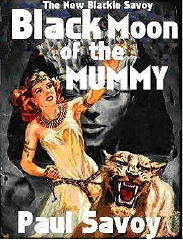
“You do not believe in the superstition, eh,
mon ami?” Inspector Dupont asked as he kneeled over the magnificent naked form of the belly dancer, Fatima Fatale.
“I don’t believe in coincidences,” Blacke said, kneeling on the other side of the dead woman. He reached down to examine something near the girl’s neck.
“You have something?” Dupont asked with a trace of excitement in his Gallic voice.
“Do you have a pencil, Inspector?” The Frenchman reached in his jacket pocket and produced a slim silver mechanical pencil. Blackie took it and used it to remove something lying under Fatima’s throat. When he held it up to the light it was revealed as a scrap of dirty cloth.
“What is it?” Dupont asked.
“I think,” Blackie said staring intently at the scrap of cloth, “the police lab will find it is linen, treated with chemicals, and I would guess about three thousand years old.”
“Non!” Dupont exclaimed.
“Oh, yes, my friend. The mummy’s shroud.”
Readers who have read the article on Paul Savoy and his creation Blackie Savoy (announced previously here on the blog) may be interested in this one, a look at what many consider his best book, Black Moon of the Mummy.
In this one Blackie is tagging along with Wanda, his long time lover, who for a change isn’t merely arm candy. Wanda has taken a movie job in a major production for eccentric fat British director and gourmand, Elwood Hotchkiss. The film, Nights with Nefertiti, is the story of the legendary queen, mother of Tutankhamen and wife of the apostate pharaoh Akenaten.
The film is based on a racy novel by Burton St. James, a hard drinking Oxford scholar who is less than happy his book is being butchered by the cavalier Hotchkiss.
“You know,” Wanda said. “I thought if anyone was going to be murdered on this little jaunt it would be Elwood or Burton. I’ve been expecting the set to erupt in bloodshed any day now.”
“Good,” Blackie said. “We can’t have the only murder this early in the business. I’d hate to think all we had to contend with is a belly dancer strangled by a three thousand year old mummy. Positively boring, that.”
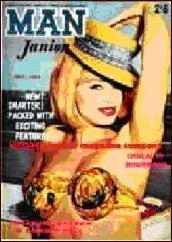
The movie is being made on location in Egypt, in a massive recreation of the city of Amarna near the Valley of the Kings. Dawas Ben Ali is a local historian and Egyptian official horrified by the liberties being taken with his countries history by the book and film; Neal Wilde is the actor playing Akenaten, a closeted homosexual trying to hold on to his looks and status as a leading man; and Althea Lovington is a legendary actress cast as Akenaten’s mother and less than happy that Wanda seems set to replace her as a screen sex symbol.
Anyone of them might have had a motive to murder Fatima. Ben Ali to sabotage the film (Fatima had a small but key role); Neal Wilde, who had been humiliated when he tried to seduce the belly dancer in order to disprove accusations of his homosexuality; Althea Lovington, who may have had Sapphic designs on the sexy dancer; and either the fat Hotchkiss whose advances had been spurned by Fatima or St. James who had made a drunken pass at her at a cast party the night she died.
But Blackie suspects something darker and more dangerous:
“Morphy?” Dupont practically choked on the word. “
Mon ami, you have the man on the brain! What could Professor Morphy possibly want with a movie? No,
mon ami, you have spent too much time in the sun, I think.”
“Perhaps,” Blackie said. “But I wouldn’t rule him out, Inspector. Maybe I am being paranoid and seeing master criminals popping up out of the shadows, but I smell a super villain’s hand in this, and no hand stinks of blood as much as Humbert Morphy’s.”
And, as usual, Blackie is right. Morphy’s fine Irish hand is indeed involved, for the film has built its recreation of Akenaten’s city of Amarna on the site where Morphy believes he has located the lost tomb of Nefertiti, and the fabulous riches buried with her. He has been behind the murder of Fatima — she stumbled on one of him as he was spying on the film set, and responsible for the ‘accidents’ on the set as well as the sightings of the black shrouded mummy that guards the tomb.
Blackie tracks Morphy down to the lost tomb, but Morphy gets the drop on him.
“At last, Savoy, I shall be rid of your meddlesome ways. You can rest here in peace in the lost tomb of the queen while I loot her fabulous treasure to fund my brilliant schemes.” The torches cast ominous shadows on the decorated walls and Morphy seemed more grotesque than ever in the setting, his twisted features made even more hideous by his gloating smile.
“I wouldn’t count my amphora before I had stolen them,” Savoy said. ” You should ask our friend there behind you, first.”
“Friend? Oh — you think to trick me into looking behind me. Tell me, Savoy just who is supposed to be behind me. Inspector Dupont? I happen to know our Gallic friend is in Cairo calling on the Egyptian police. Miss Delicht? She is at the cast party you skipped out on. So, my dear Savoy, just who is supposed to be lurking behind me?”
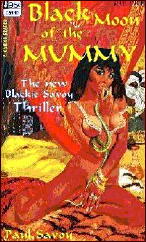
“I don’t know his name,” Blackie said, his face quite white. “But I should say he was the mummy left to guard Nefertiti’s tomb.”
Morphy’s laughter barked like a hyena. “Really Savoy. A mummy. How childish. Don’t you know it was I who planted the pieces of shroud at the site of the crimes? As for the appearances of the mummy, the fellow I hired for that role is resting comfortably in the belly of some crocodile in Nile by now. Surely you can do better than that.”
“I wish I could oblige you,” Savoy said. “But I think our visitor has taken it all out of my hands, Professor.”
And at that moment a linen shrouded hand fell upon Morphy’s shoulder.
Incidentally this isn’t the spoiler it may seem, because Savoy has one last trick up his sleeve for us and Blackie.
Black Moon of the Mummy is one of the rarest of the Savoy titles, but perhaps the one most worth the effort. It is Savoy at his best, eccentric, fast paced, and often wickedly funny. Despite the thriller elements Blackie does some actual detection, and the finale is a stunner, apocalyptic and thrilling:
“Not for nothing will this be recorded as your greatest case, Blackie,
mon ami,” Dupont said sincerely.
“And very nearly his last one,” Wanda said gripping his arm tightly as if still frightened he would somehow be lost to her.
Blackie patted her hand reassuringly. “Now, now,” he said. “I’m not going anywhere. And I suspect neither is our old friend Morphy.”
“But Morphy, this time he is dead, certainly,” Dupont said, circumnavigating the English language in his usual manner.
But Blackie was looking out across the starry skied desert as it spread before him, and of what his thoughts were at that moment no man can write, as he stared into the vastness of history seeing something neither Wanda nor Dupont could perceive, looking into the distant past and the not so distant future.
No. This much he knew. Humbert Morphy lived!
Editorial Comments: The article about Blackie Savoy and his creator, Paul Savoy, that David refers to in the first paragraph of this review, following that short lead-in excerpt, has caused quite a stir in the world of crime fiction bibliography.
Until David’s article appeared, Paul Savoy had somehow managed to avoid the scrutiny of the even the keenest collectors of crime and thriller fiction, nor do his books appear in the Revised Crime Fiction IV, by Allen J. Hubin.
It would seem that his work had vanished from existence, and in fact from the memories of everyone who should have known better. Now, however, a great-great-grandnephew has surfaced (scroll down to the comments), thanks to David’s newly published research into the life and writing career of Paul Savoy.
Not only that, but this nephew of this unjustly forgotten author claims to have discovered a closet full of both books he wrote and magazines he wrote for. It is mindboggling, to say the least, but all preliminary investigations indicate that there is a good deal of revision that needs to be done in terms of who wrote what in terms of previously unquestioned facts about Australian-based detective and thriller fiction.
These are exciting times.
Wed 14 Apr 2010
REVIEWED BY WALTER ALBERT:
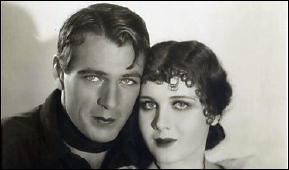
ONLY THE BRAVE. Paramount, 1930. Gary Cooper, Mary Brian, Phillips Holmes, James Neill, Morgan Farley, Guy Oliver, John Elliot, E. H. Calvert, Virginia Bruce, William LeMaire. Screenplay by Edward E. Paramore & Agnes Brand Leahy, based on a story by Keene Thompson; photography: Henry Fischbeck. Director: Frank Tuttle. Shown at Cinecon 45, Hollywood CA, September 2009.
The early ’30s Paramount films, seldom seen outside film conventions, are often among the most eagerly anticipated screenings. It was, then, something of a shock to be submitted to the inanity of this Civil War drama.
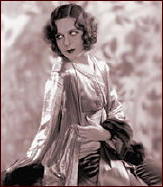
There is an initial, somewhat promising set-up as Cooper, in disgrace after going AWOL to visit his sweetheart whom he finds with another man, accepts an undercover mission.
He will travel behind enemy lines with false troop information that he will allow to fall into the hands of rebel forces, and which will undoubtedly result in his death.
He “infiltrates” a gathering at a mansion where the daughter of the house (Mary Brian) is entertaining officers, among them her fiance (Phillips Holmes). Cooper flirts openly with Brian, who falls like the proverbial ton of bricks for him in a matter of a few minutes.
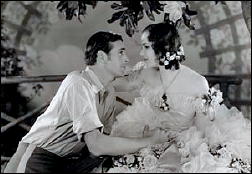
After some farcical misfires, Cooper succeeds in having himself exposed and his plans confiscated. He’s locked up with a loony soldier (played by William Le Maire, a popular vaudeville comic), while he’s waiting for the firing squad, and the sentry delivers an off-the-wall monologue in black dialect that destroys any remaining credibility in the numbing plot.
The writer of the program notes characterized the film as “weird” but “delightful.” Weird it may be, but only delightful during LeMaire’s lengthy monologue.
Wed 14 Apr 2010
IT’S ABOUT CRIME
by Marvin Lachman
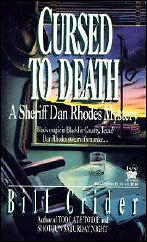
BILL CRIDER – Cursed to Death. Walker, hardcover, 1988. Paperback reprint: Ivy, 1990.
– Reprinted from
The MYSTERY FANcier,
Vol. 10, No. 4, Fall 1988.
We’re back in Blacklin County, Texas, for Cursed to Death, the third in the Sheriff Dan Rhodes series, and it is a pleasure to be there again.
The pace is relaxed, the main characters decent, and the mystery involving the disappearance of a dentist against whom someone had leveled a curse is reasonably challenging. The time is just before Christmas, and the holiday season always provides a nice contrast when one is reading about crime.
There aren’t a whole lot of clues and there is a bit of padding involving several fracases at a local nursing home. Also, Rhodes keeps getting into fights and dangerous situations because, like Pronzini’s Nameless, he doesn’t like to draw his gun.
Still, the book is extremely readable, and one walks away satisfied after spending a couple of hours in rural Texas, without either air fare or jet lag.
The Sheriff Dan Rhodes series —
1. Too Late to Die (1986)
2. Shotgun Saturday Night (1987)
3. Cursed to Death (1988)
4. Death on the Move (1989)
5. Evil at the Root (1990)
6. Booked for a Hanging (1992)
7. Murder Most Fowl (1994)
8. Winning Can Be Murder (1996)
9. Death By Accident (1997)
10. A Ghost of a Chance (2000)
11. A Romantic Way to Die (2001)
12. Red, White, and Blue Murder (2003)
13. A Mammoth Murder (2006)
14. Murder Among the O.W.L.S. (2007)
15. Of All Sad Words (2008)
16. Murder in Four Parts (2009)
17. Murder in the Air (2010)
« Previous Page — Next Page »















